Strategies of Metaverse Safety Training in Highway Construction Projects: A Tripartite Evolutionary Game
Abstract
1. Introduction
2. Literature Review
2.1. Metaverse Safety Training
2.2. Interactions Among Stakeholders’ Safety Training in HCPs
2.3. Evolutionary Game in AEC Industry
3. Methodology
3.1. Research Design
3.2. Model Assumptions
3.3. Evolutionary Game Model
3.3.1. Payoff Matrix
3.3.2. Each Stakeholders’ Expected Return
3.4. Model Analysis
3.4.1. An Evolutionary Stability Strategy Analysis of a Stakeholder
3.4.2. An Evolutionary Stability Strategy Analysis of Three Stakeholders
3.5. Simulation Analysis
- (1)
- Participant observation
- (2)
- Internal files
- (3)
- Delphi method
4. Results
4.1. The Impact of Owners’ Policy Support and Financial Incentives
4.2. The Impact of Contractors’ Incentives
4.3. The Impact of Contractors’ Penalties
5. Discussions
5.1. Redefining Stakeholder Roles and Highlighting Owners’ Indirect Influence in MST
5.2. Considering More on Construction Crews Rather than Construction Workers
5.3. Balancing Reward and Penalty
5.4. The Complexity and Dynamic Interactions Between Agents
6. Conclusions
- (1)
- The choice of behavioral strategies and evolutionary paths for any given game stakeholder is closely related to the strategies of other stakeholders. Additionally, there are significant differences in the extent to which each stakeholder influences the initial strategies of the others. When formulating policy support and financial incentive strategies, the demands and expectations of all stakeholders must be fully considered. Policymakers and contractors must understand how these incentives affect stakeholders’ expectations of MST. Effective incentives with subcontractors and construction crews should be established for contractors to ensure a stable state of MST.
- (2)
- Owners’ policy support and financial incentives have a positive effect on contractors. These strategies can alleviate the economic burden on contractors in the context of MST and stimulate motivation for supervision. At the same time, increasing rewards for subcontractors and construction crews by the contractor is conducive to achieving a collaborative synergy among the three stakeholders, thereby promoting the positive evolution of the game system. However, excessive rewards may hinder the beneficial evolution of the system. When contractors provide excessive rewards, it can lead to an unfair work environment and competition. Therefore, contractors should increase their investment within a moderate range to promote collaboration among the three parties and enhance the effectiveness of MST.
- (3)
- The benefits gained from enhancing MST effectiveness have a positive impact on subcontractors. Although enhancing the effectiveness of MST incurs certain costs, the benefits it yields far outweigh expenses. These benefits are not only reflected in direct economic gains (such as reduced operational costs and increased project success rates) but also manifest in the long-term competitiveness and sustainability of the enterprises. Subcontractors should pay more attention to social benefits and sustainable development to adopt more environmentally friendly, healthy measures and contribute to HCPs.
- (4)
- The enhancement of reward and penalty measures has a significant positive impact on the enthusiasm of construction crews to participate in MST. Increased intensity of rewards and penalties indicates a marked elevation in the attention project managers place on MST. The clear signal makes construction crews realize that MST is not merely a routine task but is directly related to their professional development. The reward mechanism can directly stimulate the enthusiasm of the construction crew to participate in MST. Whether in the form of material or non-material rewards, it allows the construction crew to recognize the benefits that can be gained through their diligent participation in MST. Corresponding to rewards is the penalty mechanism. When the intensity of rewards and penalties increases, individuals who fail to participate in or engage half-heartedly in safety training may face more severe consequences, such as fines or even termination of employment. The constraint mechanism creates an external pressure that compels members of the construction crew to take training seriously, in order to avoid incurring costs due to their own negligence or laziness. The intensification of rewards and penalties may foster an atmosphere of both competition and collaboration within the construction crew. Construction workers will motivate and assist one another, collectively enhancing safety awareness and skill levels.
Author Contributions
Funding
Institutional Review Board Statement
Informed Consent Statement
Data Availability Statement
Conflicts of Interest
References
- Awolusi, I.; Marks, E.D. Active Work Zone Safety: Preventing Accidents Using Intrusion Sensing Technologies. Front. Built Environ. 2019, 5, 21. [Google Scholar] [CrossRef]
- Nnaji, C.; Lee, H.W.; Karakhan, A.; Gambatese, J. Developing a Decision-Making Framework to Select Safety Technologies for Highway Construction. J. Constr. Eng. Manag. 2018, 144, 04018016. [Google Scholar] [CrossRef]
- Rashid, H.M.; Ahmed, A.; Wali, B.; Qureshi, N.A. An analysis of highway work zone safety practices in Pakistan. Int. J. Inj. Control Saf. Promot. 2019, 26, 37–44. [Google Scholar] [CrossRef]
- Arditi, D.; Lee, D.-E.; Polat, G. Fatal accidents in nighttime vs. daytime highway construction work zones. J. Saf. Res. 2007, 38, 399–405. [Google Scholar] [CrossRef]
- Kim Young, A.; Ryoo Boong, Y.; Kim, Y.-S.; Huh Woon, C. Major Accident Factors for Effective Safety Management of Highway Construction Projects. J. Constr. Eng. Manag. 2013, 139, 628–640. [Google Scholar] [CrossRef]
- Li, Y.; Hu, Y.; Xia, B.; Skitmore, M.; Li, H. Proactive behavior-based system for controlling safety risks in urban highway construction megaprojects. Autom. Constr. 2018, 95, 118–128. [Google Scholar] [CrossRef]
- Scorgie, D.; Feng, Z.; Paes, D.; Parisi, F.; Yiu, T.W.; Lovreglio, R. Virtual reality for safety training: A systematic literature review and meta-analysis. Saf. Sci. 2024, 171, 106372. [Google Scholar] [CrossRef]
- Chen, T.-T.; Leu, S.-S. Fall risk assessment of cantilever bridge projects using Bayesian network. Saf. Sci. 2014, 70, 161–171. [Google Scholar] [CrossRef]
- Xu, S.; Zhang, M.; Hou, L. Formulating a learner model for evaluating construction workers’ learning ability during safety training. Saf. Sci. 2019, 116, 97–107. [Google Scholar] [CrossRef]
- Din, Z.U.; Gibson, G.E., Jr. Serious games for learning prevention through design concepts: An experimental study. Saf. Sci. 2019, 115, 176–187. [Google Scholar] [CrossRef]
- Pamucar, D.; Deveci, M.; Gokasar, I.; Tavana, M.; Köppen, M. A metaverse assessment model for sustainable transportation using ordinal priority approach and Aczel-Alsina norms. Technol. Forecast. Soc. Change 2022, 182, 121778. [Google Scholar] [CrossRef]
- Park, S.M.; Kim, Y.G. A Metaverse: Taxonomy, Components, Applications, and Open Challenges. IEEE Access 2022, 10, 4209–4251. [Google Scholar] [CrossRef]
- Riva, G.; Wiederhold, B.K. What the Metaverse Is (Really) and Why We Need to Know About It. Cyberpsychol Behav. Soc. Netw. 2022, 25, 355–359. [Google Scholar] [CrossRef] [PubMed]
- Dwivedi, Y.K.; Hughes, L.; Wang, Y.; Alalwan, A.A.; Ahn, S.J.; Balakrishnan, J.; Wirtz, J. Metaverse marketing: How the metaverse will shape the future of consumer research and practice. Psychol. Mark. 2023, 40, 750–776. [Google Scholar] [CrossRef]
- Oh, H.J.; Kim, J.; Chang, J.J.C.; Park, N.; Lee, S. Social benefits of living in the metaverse: The relationships among social presence, supportive interaction, social self-efficacy, and feelings of loneliness. Comput. Hum. Behav. 2023, 139, 107498. [Google Scholar] [CrossRef]
- Guo, Z.; Wang, Q.; Peng, C.; Zhuang, S.; Yang, B. Willingness to accept metaverse safety training for construction workers based on extended UTAUT. Front. Public Health 2024, 11, 1294203. [Google Scholar] [CrossRef]
- Lee, J.; Kundu, P. Integrated cyber-physical systems and industrial metaverse for remote manufacturing. Manuf. Lett. 2022, 34, 12–15. [Google Scholar] [CrossRef]
- Gu, J.; Wang, J.; Guo, X.; Liu, G.; Qin, S.; Bi, Z. A Metaverse-Based Teaching Building Evacuation Training System with Deep Reinforcement Learning. IEEE Trans. Syst. MAN Cybern. Syst. 2023, 53, 2209–2219. [Google Scholar] [CrossRef]
- Guo, H.; Li, H.; Chan, G.; Skitmore, M. Using game technologies to improve the safety of construction plant operations. Accid. Anal. Prev. 2012, 48, 204–213. [Google Scholar] [CrossRef]
- Bao, L.; Tran, S.V.-T.; Nguyen, T.L.; Pham, H.C.; Lee, D.; Park, C. Cross-platform virtual reality for real-time construction safety training using immersive web and industry foundation classes. Autom. Constr. 2022, 143, 104565. [Google Scholar] [CrossRef]
- Han, Y.; Yang, J.; Diao, Y.; Jin, R.; Guo, B.; Adamu, Z. Process and Outcome-based Evaluation between Virtual Reality-driven and Traditional Construction Safety Training. Adv. Eng. Inform. 2022, 52, 101634. [Google Scholar] [CrossRef]
- Shayesteh, S.; Ojha, A.; Liu, Y.; Jebelli, H. Human-robot teaming in construction: Evaluative safety training through the integration of immersive technologies and wearable physiological sensing. Saf. Sci. 2023, 159, 106019. [Google Scholar] [CrossRef]
- Daniel, E.I.; Pasquire, C.; Dickens, G.; Ballard, H.G. The relationship between the last planner® system and collaborative planning practice in UK construction. Eng. Constr. Archit. Manag. 2017, 24, 407–425. [Google Scholar] [CrossRef]
- Marin, L.S.; Roelofs, C. Promoting Construction Supervisors’ Safety-Efficacy to Improve Safety Climate: Training Intervention Trial. J. Constr. Eng. Manag. 2017, 143, 04017037. [Google Scholar] [CrossRef]
- Kim, N.K.; Rahim, N.F.A.; Iranmanesh, M.; Foroughi, B. The role of the safety climate in the successful implementation of safety management systems. Saf. Sci. 2019, 118, 48–56. [Google Scholar] [CrossRef]
- Arif, M.; Nasir, A.R.; Thaheem, M.J.; Khan, K.I.A. ConSafe4All: A framework for language friendly safety training modules. Saf. Sci. 2021, 141, 105329. [Google Scholar] [CrossRef]
- Dou, Y.; Sun, X.; Ji, A.; Wang, Y.; Xue, X. Development strategy for prefabricated construction projects: A tripartite evolutionary game based on prospect theory. Eng. Constr. Archit. Manag. 2023, 30, 105–124. [Google Scholar] [CrossRef]
- An, X.; Ren, S.; Wang, L.; Huang, Y. Evolutionary game analysis of collaborative application of BIM platform from the perspective of value co-creation. Eng. Constr. Archit. Manag. 2024, 32, 4458–4474. [Google Scholar] [CrossRef]
- Zhang, N.; Deng, X.; Hwang, B.-G.; Bi, M.; Mahmoudi, A. A Novel Approach to Selecting the Best Partner for High-Speed Rail Firms. Eng. Constr. Archit. Manag. 2021, 29, 2130–2152. [Google Scholar] [CrossRef]
- Zhu, J.; Shi, Q.; Zhang, C.; Yuan, J.; Li, Q.; Wang, X. Investigating cooperative strategies in low-carbon public–private partnership projects through evolutionary game. Eng. Constr. Archit. Manag. 2022, 31, 789–811. [Google Scholar] [CrossRef]
- Buhalis, D.; Leung, D.; Lin, M. Metaverse as a disruptive technology revolutionising tourism management and marketing. Tour. Manag. 2023, 97, 104724. [Google Scholar] [CrossRef]
- Han, E.; Miller, M.R.; DeVeaux, C.; Jun, H.; Nowak, K.L.; Hancock, J.T.; Bailenson, J.N. People, places, and time: A large-scale, longitudinal study of transformed avatars and environmental context in group interaction in the metaverse. J. Comput.-Mediat. Commun. 2023, 28, zmac031. [Google Scholar] [CrossRef]
- Almeida, L.G.G.; Vasconcelos, N.V.D.; Winkler, I.; Catapan, M.F. Innovating Industrial Training with Immersive Metaverses: A Method for Developing Cross-Platform Virtual Reality Environments. Appl. Sci. 2023, 13, 8915. [Google Scholar] [CrossRef]
- Wang, J.; Chen, S.; Liu, Y.; Lau, R. Intelligent Metaverse Scene Content Construction. IEEE Access 2023, 11, 76222–76241. [Google Scholar] [CrossRef]
- Lee, U.-K.; Kim, H. UTAUT in Metaverse: An “Ifland” Case. J. Theor. Appl. Electron. Commer. Res. 2022, 17, 613–635. [Google Scholar] [CrossRef]
- Teng, Z.; Cai, Y.; Gao, Y.; Zhang, X.; Xinlong, L. Factors Affecting Learners’ Adoption of an Educational Metaverse Platform: An Empirical Study Based on an Extended UTAUT Model. Mob. Inf. Syst. 2022, 2022, 5479215. [Google Scholar] [CrossRef]
- Nykänen, M.; Puro, V.; Tiikkaja, M.; Kannisto, H.; Lantto, E.; Simpura, F.; Teperi, A.-M. Implementing and evaluating novel safety training methods for construction sector workers: Results of a randomized controlled trial. J. Saf. Res. 2020, 75, 205–221. [Google Scholar] [CrossRef]
- Ayouz, H.; Alzubi, A.; Iyiola, K. Using benevolent leadership to improve safety behaviour in the construction industry: A moderated mediation model of safety knowledge and safety training and education. Int. J. Occup. Saf. Ergon. 2024, 31, 167–180. [Google Scholar] [CrossRef]
- Li, W.; Huang, H.; Solomon, T.; Esmaeili, B.; Yu, L.-F. Synthesizing Personalized Construction Safety Training Scenarios for VR Training. IEEE Trans. Vis. Comput. Graph. 2022, 28, 1993–2002. [Google Scholar] [CrossRef]
- Yoo, J.W.; Park, J.S.; Park, H.J. Understanding VR-Based Construction Safety Training Effectiveness: The Role of Telepresence, Risk Perception, and Training Satisfaction. Appl. Sci. 2023, 13, 1135. [Google Scholar] [CrossRef]
- Ahn, S.Z. Using Building Information Modeling (BIM) in Construction Worker Safety Training. Ph.D. Thesis, University of Florida, Gainesville, FL, USA, 2016. [Google Scholar]
- Adami, P.; Rodrigues, P.B.; Woods, P.J.; Becerik-Gerber, B.; Soibelman, L.; Copur-Gencturk, Y.; Lucas, G. Effectiveness of VR-based training on improving construction workers’ knowledge, skills, and safety behavior in robotic teleoperation. Adv. Eng. Inform. 2021, 50, 101431. [Google Scholar] [CrossRef]
- Hinze, J.; Gambatese, J. Factors That Influence Safety Performance of Specialty Contractors. J. Constr. Eng. Manag. 2003, 129, 159–164. [Google Scholar] [CrossRef]
- Liang, Q.; Zhou, Z.; Ye, G.; Shen, L. Unveiling the mechanism of construction workers’ unsafe behaviors from an occupational stress perspective: A qualitative and quantitative examination of a stress–cognition–safety model. Saf. Sci. 2022, 145, 105486. [Google Scholar] [CrossRef]
- Demirkesen, S.; Arditi, D. Construction safety personnel’s perceptions of safety training practices. Int. J. Proj. Manag. 2015, 33, 1160–1169. [Google Scholar] [CrossRef]
- Sunindijo Riza, Y.; Zou Patrick, X.W. Conceptualizing Safety Management in Construction Projects. J. Constr. Eng. Manag. 2013, 139, 1144–1153. [Google Scholar] [CrossRef]
- Hammer, L.B.; Truxillo, D.M.; Bodner, T.; Pytlovany, A.C.; Richman, A. Exploration of the impact of organisational context on a workplace safety and health intervention. Work Stress 2019, 33, 192–210. [Google Scholar] [CrossRef]
- Loosemore, M.; Malouf, N. Safety training and positive safety attitude formation in the Australian construction industry. Saf. Sci. 2019, 113, 233–243. [Google Scholar] [CrossRef]
- Jia, G.; Chen, Y.; Xue, X.; Chen, J.; Cao, J.; Tang, K. Program management organization maturity integrated model for mega construction programs in China. Int. J. Proj. Manag. 2011, 29, 834–845. [Google Scholar] [CrossRef]
- Carrillo, P.; Ruikar, K.; Fuller, P. When will we learn? Improving lessons learned practice in construction. Int. J. Proj. Manag. 2013, 31, 567–578. [Google Scholar] [CrossRef]
- Schärrer, L.; Sender, A. Boomerang independent contractors: An experimental study using a psychological contract approach. Int. J. Hum. Resour. Manag. 2023, 34, 966–986. [Google Scholar] [CrossRef]
- Chen, W.T.; Lu, C.S.; Liu, S.-S.; Wang, M.-S. Measuring the perception of safety among taiwan construction managERS. J. Civ. Eng. Manag. 2013, 19, 37–48. [Google Scholar] [CrossRef]
- Cheng, C.-W.; Wu, T.-C. An investigation and analysis of major accidents involving foreign workers in Taiwan’s manufacture and construction industries. Saf. Sci. 2013, 57, 223–235. [Google Scholar] [CrossRef]
- Wang, G.; Chao, Y.; Cao, Y.; Jiang, T.; Han, W.; Chen, Z. A comprehensive review of research works based on evolutionary game theory for sustainable energy development. Energy Rep. 2022, 8, 114–136. [Google Scholar] [CrossRef]
- Jide, S.; Xincheng, W.; Liangfa, S. Chinese construction workers’ behaviour towards attending vocational skills trainings: Evolutionary game theory with government participation. J. Differ. Equ. Appl. 2016, 23, 468–485. [Google Scholar] [CrossRef]
- Piri, L.; Ghezavati, V.; Hafezalkotob, A. Developing a new model for simultaneous scheduling of two grand projects based on game theory and solving the model with Benders decomposition. Front. Eng. Manag. 2020, 9, 117–134. [Google Scholar] [CrossRef]
- Ding, H.; Wang, Y.; Guo, S.; Xu, X.; Che, C. Game analysis and benefit allocation in international projects among owner, supervisor and contractor. Int. J. Gen. Syst. 2016, 45, 253–270. [Google Scholar] [CrossRef]
- Nasirzadeh, F.; Mazandaranizadeh, H.; Rouhparvar, M. Quantitative Risk Allocation in Construction Projects Using Cooperative-Bargaining Game Theory. Int. J. Civ. Eng. 2016, 14, 161–170. [Google Scholar] [CrossRef]
- Li, X.; Wang, C.; Alashwal, A.; Shilpi, B. Game analysis on prefabricated building evolution based on dynamic revenue risks in China. J. Clean. Prod. 2020, 267, 121730. [Google Scholar] [CrossRef]
- Ma, T.; Jiyong, D.; Wang, Z.; Skibniewski, M. Governing Government-Project Owner Relationships in Water Megaprojects: A Concession Game Analysis on Allocation of Control Rights. Water Resour. Manag. 2020, 34, 4003–4018. [Google Scholar] [CrossRef] [PubMed]
- Wang, W.; Zhang, Y.; Feng, L.; Wu, Y.; Dong, T. A System Dynamics Model for Safety Supervision of Online Car-Hailing from an Evolutionary Game Theory Perspective. IEEE Access 2020, 8, 185045–185058. [Google Scholar] [CrossRef]
- Wang, Z.L.; Wang, G.; Zuo, J.; Guangdong, W.; Liu, B. To be green or not to be: How environmental regulations shape contractor greenwashing behaviors in construction projects. Sustain. Cities Soc. 2020, 63, 102462. [Google Scholar] [CrossRef]
- Ahmed, M.; El-adaway, I.; Coatney, K. Solving the Negative Earnings Dilemma of Multistage Bidding in Public Construction and Infrastructure Projects: A Game Theory-Based Approach. J. Manag. Eng. 2021, 38, 04021087. [Google Scholar] [CrossRef]
- Zhu, X.-X.; Mu, Q.-R.; Liang, W.-Z. An Innovative Strategic Choice for Stakeholders in the Chinese Traditional Commercial Street Renewal Using Evolutionary Game Theory. J. Innov. Knowl. 2022, 7, 100225. [Google Scholar] [CrossRef]
- Wang, Y.; Fan, R.; Chen, R.; Xie, X.; Ke, C. Exploring the coevolution dynamics of residents and recyclers in electric vehicle battery recycling decisions on the two-layer heterogeneous complex networks. Appl. Energy 2025, 382, 125235. [Google Scholar] [CrossRef]
- Zhu, C.; Fan, R.; Lin, J.; Chen, R.; Luo, M. How to promote municipal household waste management by waste classification and recycling? A stochastic tripartite evolutionary game analysis. J. Environ. Manag. 2023, 344, 118503. [Google Scholar] [CrossRef]
- Zhang, Y.; Yi, X.; Li, S.; Qiu, H. Evolutionary game of government safety supervision for prefabricated building construction using system dynamics. Eng. Constr. Archit. Manag. 2023, 30, 2947–2968. [Google Scholar] [CrossRef]
- Schwatka, N.V.; Goldenhar, L.M.; Johnson, S.K.; Beldon, M.A.; Tessler, J.; Dennerlein, J.T.; Trieu, H. A training intervention to improve frontline construction leaders’ safety leadership practices and overall jobsite safety climate. J. Saf. Res. 2019, 70, 253–262. [Google Scholar] [CrossRef]
- Schwatka, N.V.; Goldenhar, L.M.; Johnson, S.K. Change in frontline supervisors’ safety leadership practices after participating in a leadership training program: Does company size matter? J. Saf. Res. 2020, 74, 199–205. [Google Scholar] [CrossRef]
- Al-Bayati, A. Satisfying the Need for Diversity Training for Hispanic Construction Workers and Their Supervisors at U.S. Construction Workplaces: A Case Study. J. Constr. Eng. Manag. 2019, 145, 05019007. [Google Scholar] [CrossRef]
- Lyu, S.; Hon, C.K.H.; Chan, A.P.C.; Javed, A.A.; Zhang, R.P.; Wong, F.K.W. An exploratory study of safety communication networks of ethnic minority crews in the Hong Kong construction industry. Eng. Constr. Archit. Manag. 2021, 28, 1156–1175. [Google Scholar] [CrossRef]
- Jeschke, K.C.; Kines, P.; Rasmussen, L.; Andersen, L.P.S.; Dyreborg, J.; Ajslev, J.; Andersen, L.L. Process evaluation of a Toolbox-training program for construction foremen in Denmark. Saf. Sci. 2017, 94, 152–160. [Google Scholar] [CrossRef]
- Eisenhardt, K.M. Building Theories from Case Study Research. Acad. Manag. Rev. 1989, 14, 532–550. [Google Scholar] [CrossRef]
- Jian, Q.; Li, X.; Xia, C. Impact of reputation assortment on tag-mediated altruistic behaviors in the spatial lattice. Appl. Math. Comput. 2021, 396, 125928. [Google Scholar] [CrossRef]
- Zhang, F.; Wu, L.; Liu, W.; Ding, K.; Hui, J.; Leng, J.; Zhou, X. Evolutionary game-based incentive models for sustainable trust enhancement in a blockchained shared manufacturing network. Adv. Eng. Inform. 2022, 54, 101791. [Google Scholar] [CrossRef]
- Yuan, M.; Li, Z.; Li, X.; Li, L.; Zhang, S.; Luo, X. How to promote the sustainable development of prefabricated residential buildings in China: A tripartite evolutionary game analysis. J. Clean. Prod. 2022, 349, 131423. [Google Scholar] [CrossRef]
- Chen, K.; Ren, Z.; Mu, S.; Sun, T.; Mu, R. Integrating the Delphi survey into scenario planning for China’s renewable energy development strategy towards 2030. Technol. Forecast. Soc. Change 2020, 158, 120157. [Google Scholar] [CrossRef]
- Ulubeyli, S.; Kazaz, A.; Er, B. Health and Safety Perception of Workers in Turkey: A Survey of Construction Sites. Int. J. Occup. Saf. Ergon. 2014, 20, 323–338. [Google Scholar] [CrossRef] [PubMed]
- Schöbel, S.M.; Leimeister, J.M. Metaverse platform ecosystems. Electron. Mark. 2023, 33, 12. [Google Scholar] [CrossRef]
- Goldenhar, L.M.; Moran, S.K.; Colligan, M. Health and safety training in a sample of open-shop construction companies. J. Saf. Res. 2001, 32, 237–252. [Google Scholar] [CrossRef]
- Jiang, Y.; Kang, J.; Niyato, D.; Ge, X.; Xiong, Z.; Miao, C.; Shen, X. Reliable Distributed Computing for Metaverse: A Hierarchical Game-Theoretic Approach. IEEE Trans. Veh. Technol. 2023, 72, 1084–1100. [Google Scholar] [CrossRef]
- Wang, J.; Du, H.; Tian, Z.; Niyato, D.; Kang, J.; Shen, X. Semantic-Aware Sensing Information Transmission for Metaverse: A Contest Theoretic Approach. IEEE Trans. Wirel. Commun. 2023, 22, 5214–5228. [Google Scholar] [CrossRef]
- Shin, M.; Lee, H.-S.; Park, M.; Moon, M.; Han, S. A system dynamics approach for modeling construction workers’ safety attitudes and behaviors. Accid. Anal. Prev. 2014, 68, 95–105. [Google Scholar] [CrossRef]
- Wu, L.; Yu, R.; Su, W.; Ye, S. Design and implementation of a metaverse platform for traditional culture: The chime bells of Marquis Yi of Zeng. Herit. Sci. 2022, 10, 193. [Google Scholar] [CrossRef]
- China Construction Industry. Guidelines for Coordinated Development of Intelligent Construction and Building Industrialization. Ministry of Housing and Urban–Rural Development. 2020. Available online: https://www.mohurd.gov.cn/ (accessed on 17 July 2025).
- Chun, H. A study on the design education method using metaverse by wireless communication with computing for UAV-enabled B5G/6G network. Wirel. Netw. 2023, 30, 6731–6738. [Google Scholar] [CrossRef]
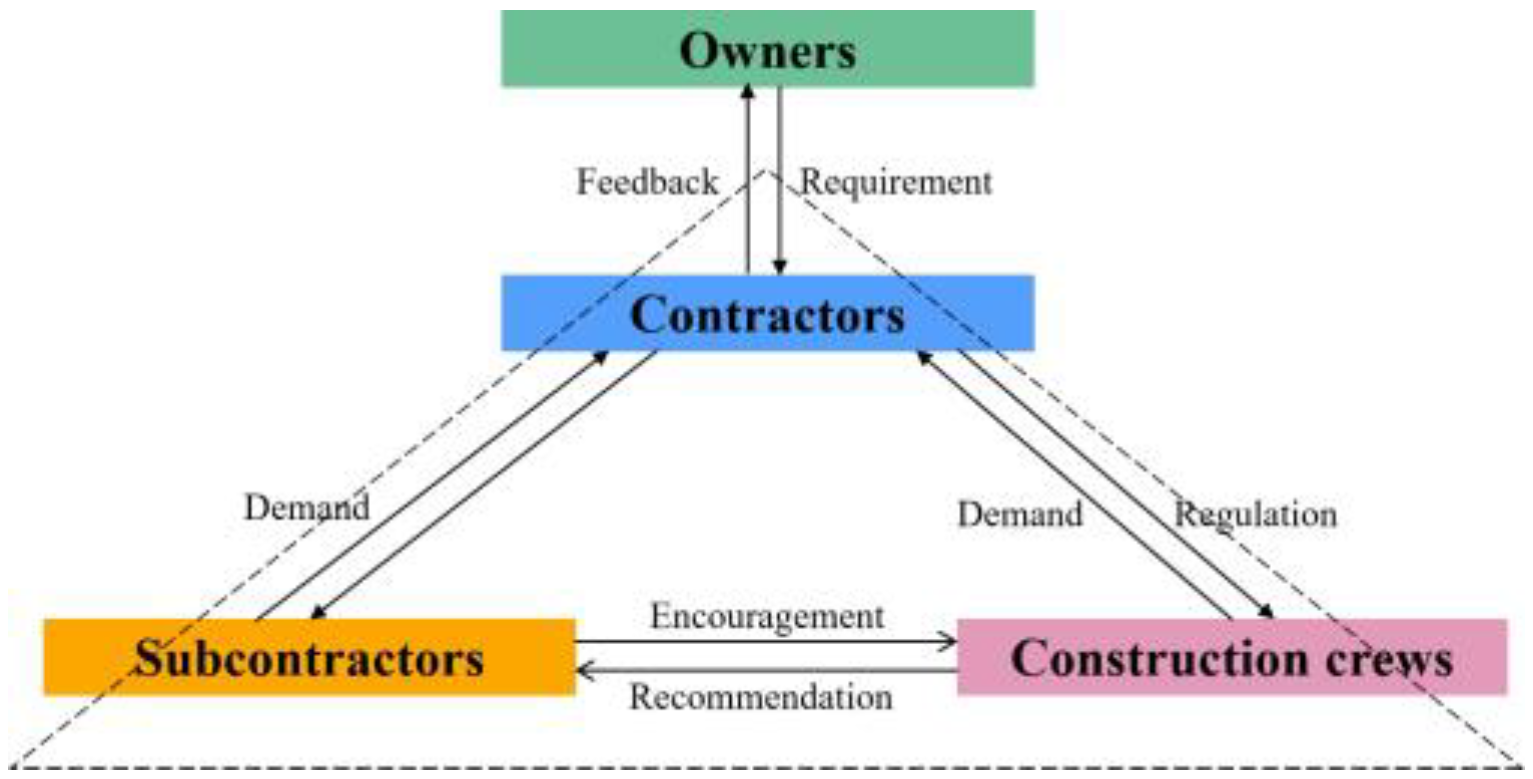
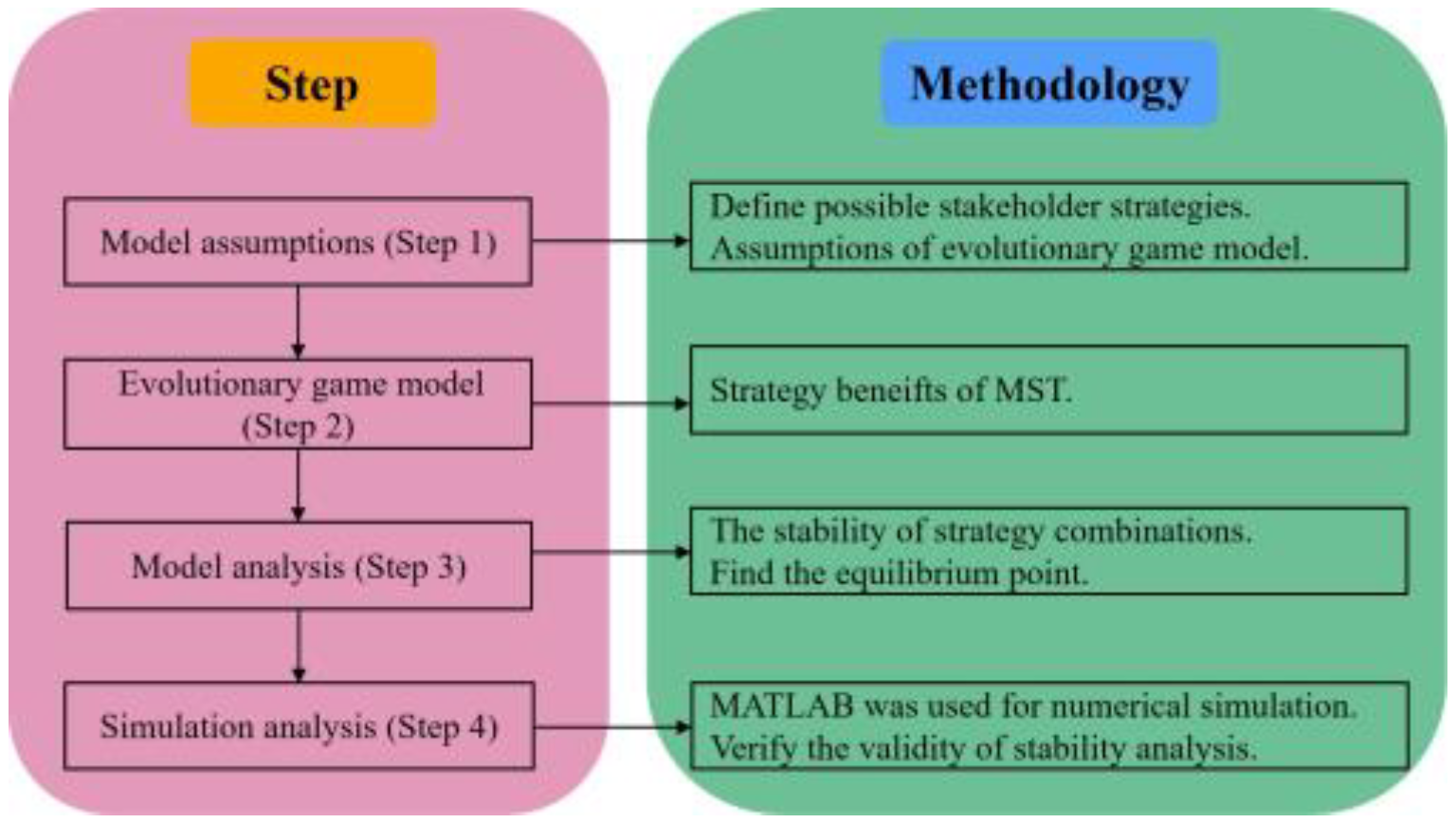
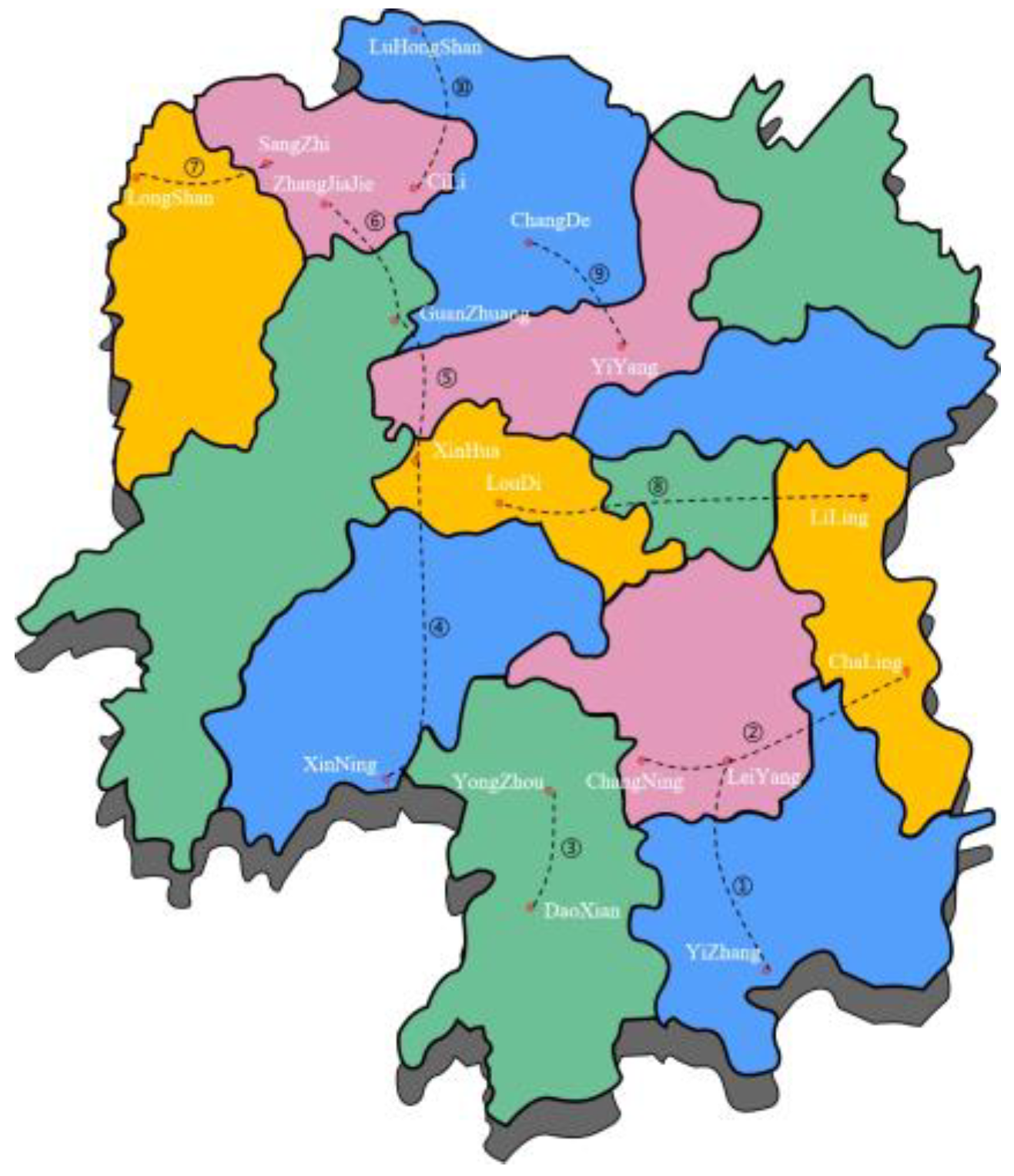
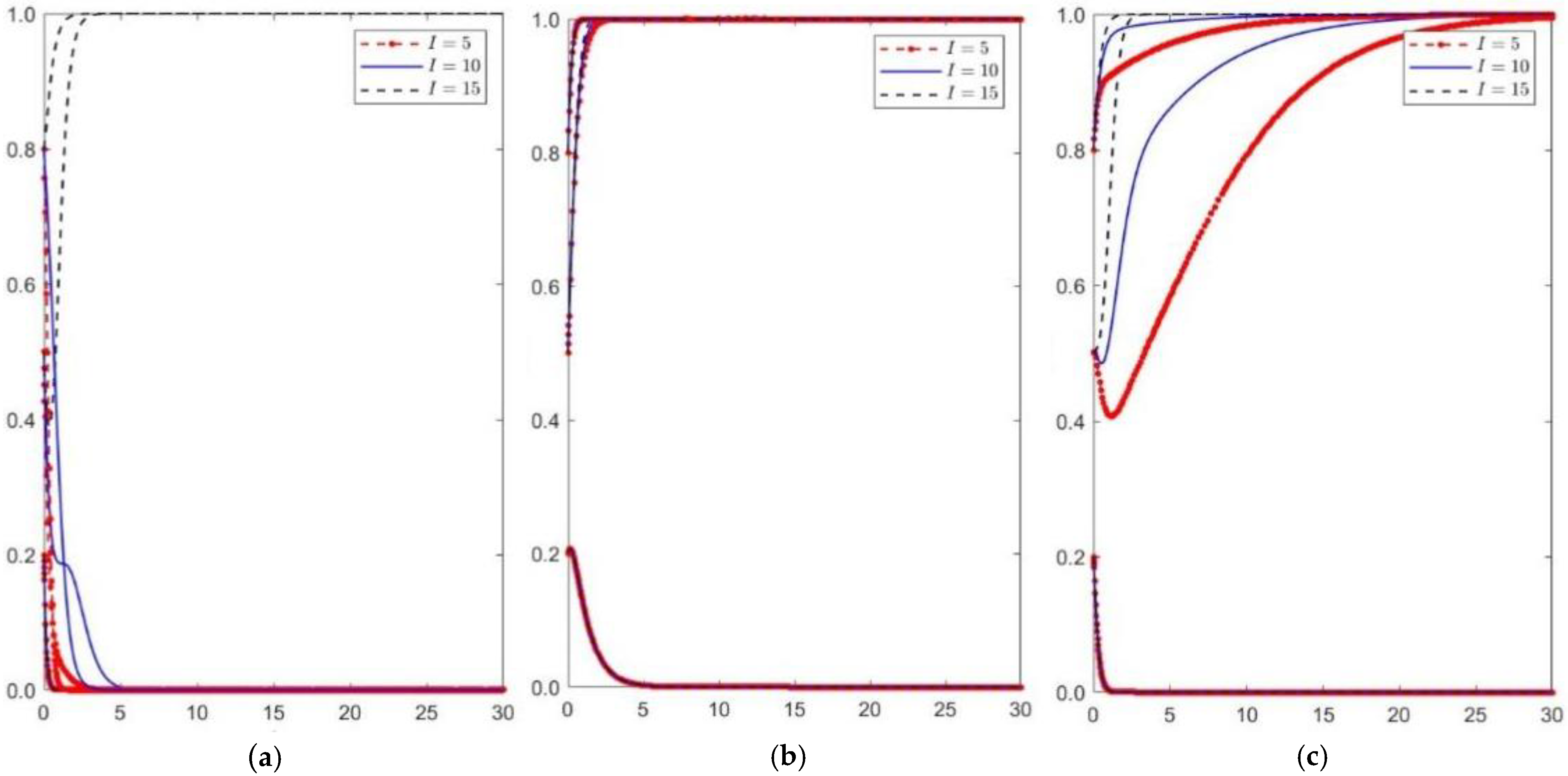

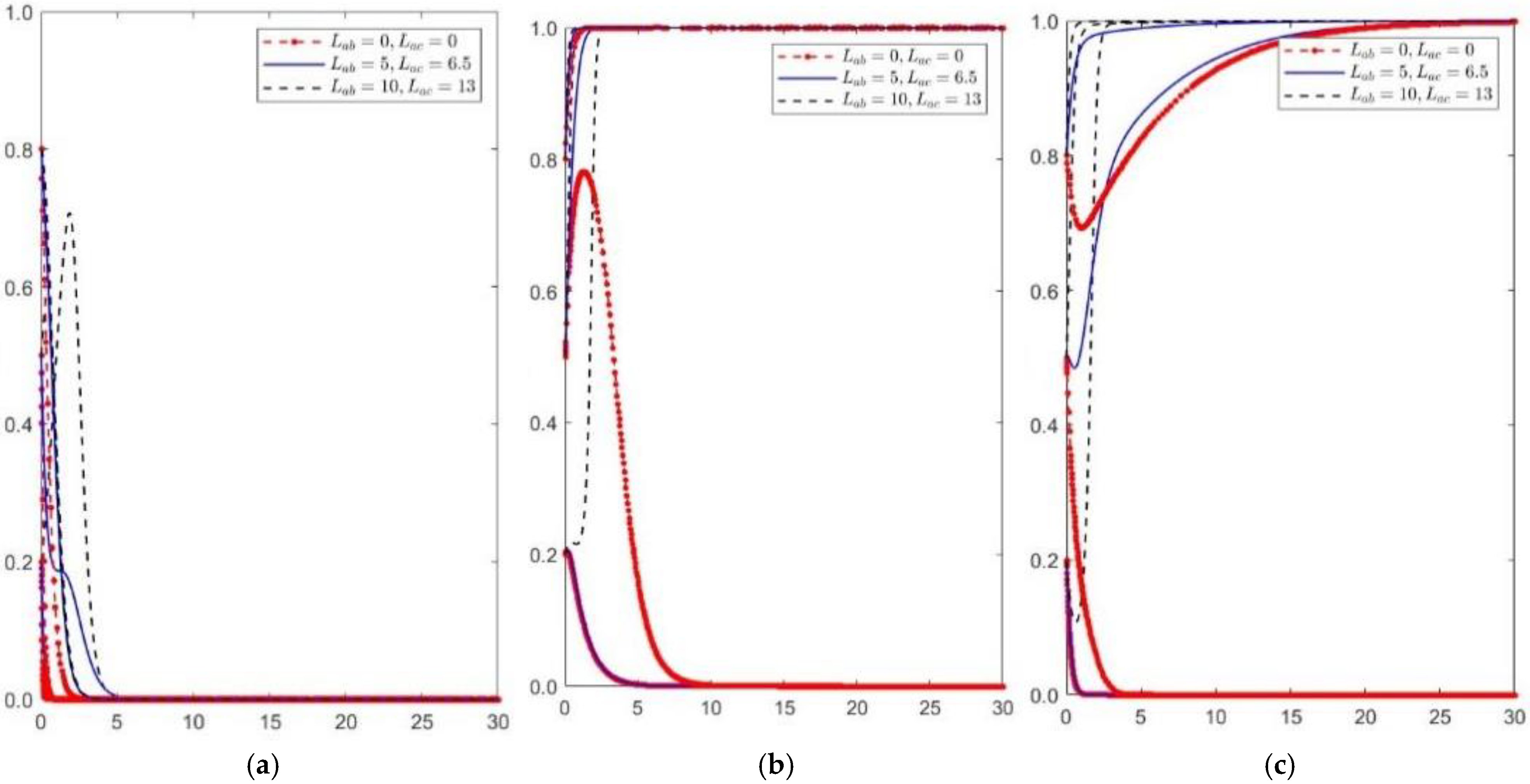
| Meanings | Parameters |
|---|---|
| (1) Positive behavior | |
| Additional cost | Ca, Cb, Cc |
| Owners’ policy support and financial incentives for contractors | I |
| Primary benefit for subcontractors and construction crews | Nb, Nc |
| Rewards given by the contractors to the subcontractors and construction crews | Rb, Rc |
| (2) Negative behavior | |
| Short-term benefit for the subcontractors | S1 |
| Short-term benefit for the construction crews | S2 |
| Penalty imposed by the contractors on the subcontractors and construction crews | Lab, Lac |
| Loss of the contractors | La |
| Strategy | Construction Crews | Contractors | ||
|---|---|---|---|---|
| Severe Supervision x | Lax Supervision 1−x | |||
| Subcontractors | Positive execution y | Positive participation z | ||
| Negative participation 1−z | ||||
| Negative execution 1−y | Positive participation z | |||
| Negative participation 1−z | ||||
| Equilibrium Point | ESS | Conclusion | Condition | |
|---|---|---|---|---|
| (0,0,0) | Uncertainty point | ** | ||
| (1,0,0) | Uncertainty point | ** | ||
| (0,1,0) | Unstable point | \ | ||
| (0,0,1) | Unstable point | \ | ||
| (1,1,0) | Uncertainty point | \ | ||
| (1,0,1) | Uncertainty point | \ | ||
| (0,1,1) | ESS | * | ||
| (1,1,1) | Unstable point | * |
| Project | Contractors and Subcontractors | Construction Crews |
|---|---|---|
| ① Leiyang–Yizhang Expressway Expansion Project | China Construction Fifth Engineering Bureau Co., Ltd., Changsha, China | Concrete Production Team 1 |
| ② Chaling–Changning Expressway | Hunan Road and Bridge Construction Group Co., Ltd., Changsha, China | Understructure Team 1 |
| ③ Lingling–Daoxian Expressway | China Railway Second Bureau Group Co., Ltd., Chengdu, China | Understructure Team 1 |
| ④ Xinhua–Xinning Expressway | Hunan Road and Bridge Construction Group Co., Ltd., Changsha, China | Pile Foundation Team 3 |
| ⑤ Guanzhuang–Xinhua Expressway | China Second Harbor Engineering Company, Wuhan, China | Pile Foundation Team 2 |
| ⑥ Zhangjiajie–Guanzhuang Expressway | China Gezhouba Group No.1 Engineering Co., Ltd., Yichang, China | Reinforcing Steel Work Team 2 |
| ⑦ Sangzhi–Longshan Expressway | China Railway Airport Construction Group Co., Ltd., Beijing, China | Concrete Production Team 3 |
| ⑧ Liling–Loudi Expressway | Hunan Expressway Huada Engineering Co., Ltd., Changsha, China | Reinforcing Steel Work Team 1 |
| ⑨ Yiyang–Changde Expressway Expansion Project | Hunan Road and Bridge Construction Group Co., Ltd., Changsha, China | Pile Foundation Team 1 |
| ⑩ Luhongshan–Cili Expressway | China Railway Airport Construction Group Co., Ltd., Beijing, China | Concrete Production Team 1 |
Disclaimer/Publisher’s Note: The statements, opinions and data contained in all publications are solely those of the individual author(s) and contributor(s) and not of MDPI and/or the editor(s). MDPI and/or the editor(s) disclaim responsibility for any injury to people or property resulting from any ideas, methods, instructions or products referred to in the content. |
© 2025 by the authors. Licensee MDPI, Basel, Switzerland. This article is an open access article distributed under the terms and conditions of the Creative Commons Attribution (CC BY) license (https://creativecommons.org/licenses/by/4.0/).
Share and Cite
Chen, C.; Tang, X. Strategies of Metaverse Safety Training in Highway Construction Projects: A Tripartite Evolutionary Game. Buildings 2025, 15, 4083. https://doi.org/10.3390/buildings15224083
Chen C, Tang X. Strategies of Metaverse Safety Training in Highway Construction Projects: A Tripartite Evolutionary Game. Buildings. 2025; 15(22):4083. https://doi.org/10.3390/buildings15224083
Chicago/Turabian StyleChen, Cheng, and Xiaoying Tang. 2025. "Strategies of Metaverse Safety Training in Highway Construction Projects: A Tripartite Evolutionary Game" Buildings 15, no. 22: 4083. https://doi.org/10.3390/buildings15224083
APA StyleChen, C., & Tang, X. (2025). Strategies of Metaverse Safety Training in Highway Construction Projects: A Tripartite Evolutionary Game. Buildings, 15(22), 4083. https://doi.org/10.3390/buildings15224083





